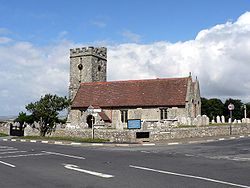Chale
| Chale | |
| Hampshire | |
|---|---|
 St Andrew's Church, Chale | |
| Location | |
| Island: | Isle of Wight |
| Grid reference: | SZ484777 |
| Location: | 50°35’47"N, 1°18’58"W |
| Data | |
| Population: | 639 (2011) |
| Post town: | Ventnor |
| Postcode: | PO38 |
| Dialling code: | 01983 |
| Local Government | |
| Council: | Isle of Wight |
| Parliamentary constituency: |
Isle of Wight |
Chale is a village on the Isle of Wight, Hampshire. It stands two miles from Niton in the south of the island in the area known as the Back of the Wight.[1] The village of Chale sits at the foot of St Catherine's Down.
History
Chale is recorded in the Domesday book as "Cela", which probably derives from the Old English word "ceole", meaning "throat". This is thought to refer to the nearby ravine or chine at Blackgang. The name was also recorded as "Chele" or "Chielle", but it has been "Chale" since the 12th century.
There were three manors in Chale at the time of the Domesday Book: Chale, Gotten and Walpen.
The Parish Church of St Andrew was founded by Hugh Gendon in Chale in 1114. However, the present church dates from the 14th century. It has 6 bells in its tower. One might have been made about 1360. It has some fine stained glass windows.
The Chale Abbey farm has a window that dates from the 14th century. The name Abbey refers to the style of the building, not its religious use. Chale Abbey Farm and Walpen Manor are two of the oldest buildings on the Isle of Wight.
The south coast of the Isle of Wight has seen many shipwrecks because it has some famous rocky outcroppings. Lord William de Godeton removed some casks of wine from a French shipwreck in 1312. However, this wine was the property of the Church, which forced Godeton to build a tower and an octagonal oratory at the top of the cliffs above Chale on St Catherine's Down, a tower known as St Catherine's Oratory. A fire was maintained in the oratory to prevent further shipwrecks. A monk remained resident in the oratory.
The Clarendon sank in Chale Bay in 1836, claiming 25 lives. The public was outraged, and demanded that a new lighthouse be built. Government officials unfamiliar with local geography decreed that the new lighthouse should be on top of St Catherine's Down, it is common for fogs to roll in and obscure the top of St Catherine's Down, and there were more wrecks even after the new lighthouse was built. A second lighthouse, still in use, was built at the foot of the cliffs.
Chale is close to Blackgang Chine amusement park, which was opened in 1843 and was Britain's first theme park.
Chale had a school by 1784. The current school building dates from 1883, although it has been much augmented and modernised since. It sits near the church and Wight Mouse Inn at the southern end of the parish. The school in its day was the smallest on the Island, and one of the smallest in the United Kingdom with only 20 pupils on roll.
The Wight Mouse Inn and Clarendon Hotel is named after a shipwreck in 1835. Some of the timbers from the wreck are part of the building. It was a popular destination of the upper classes in an earlier era.
Outside links
| ("Wikimedia Commons" has material about Chale) |
References
- ↑ [http://www.backofthewight.net BackOfTheWight.net
